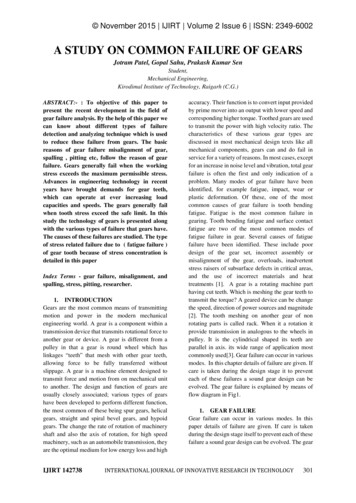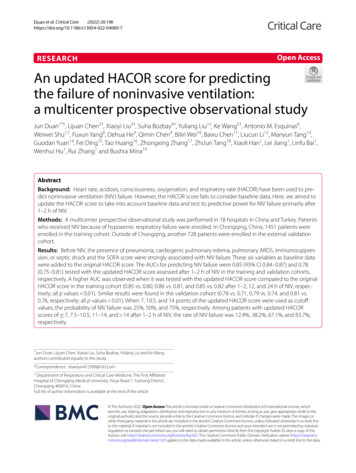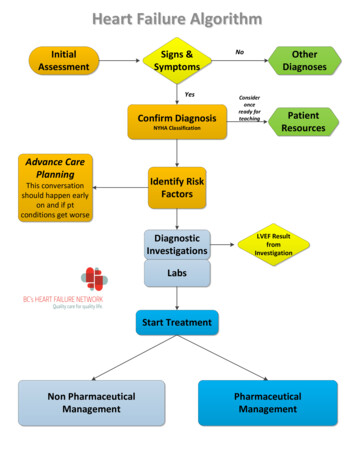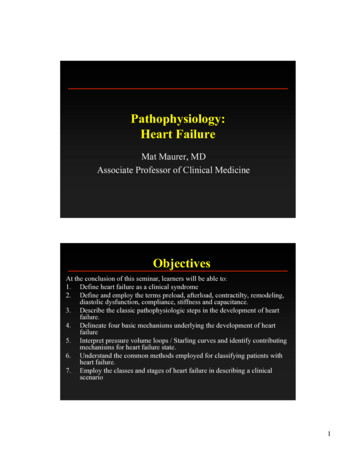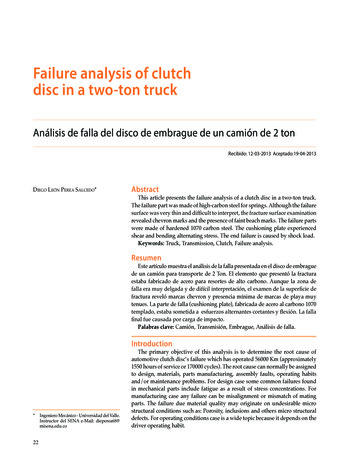
Transcription
The AFT model frameworkEstimation and inferencesurvregAccelerated Failure Time ModelsPatrick BrehenyOctober 15Patrick BrehenySurvival Data Analysis (BIOS 7210)1/25
The AFT model frameworkEstimation and inferencesurvregIntroductionExample: The lognormal AFTMeaning of AFT modelsIntroductionLast time, we introduced the Weibull distribution and sawthat, on the log scale, it could be viewed, essentially, as aregular linear regression model, albeit with extreme valueresidual termsToday we will look at this modeling framework in more detail,discuss estimation and model fitting, and go through anexample in which we fit the model to real dataPatrick BrehenySurvival Data Analysis (BIOS 7210)2/25
The AFT model frameworkEstimation and inferencesurvregIntroductionExample: The lognormal AFTMeaning of AFT modelsAccelerated failure time modelsFor a random time-to-event T , an accelerated failure time(AFT) model proposes the following relationship betweencovariates and Y log T :Yi xTi β Wi ,iidwhere Wi f are the error, or residual, terms; such modelsare also sometimes referred to as log-linear modelsThe above framework describes a general class of models:depending on the distribution we specify for W , we will obtaina different model, but all will have the same general structurePatrick BrehenySurvival Data Analysis (BIOS 7210)3/25
The AFT model frameworkEstimation and inferencesurvregIntroductionExample: The lognormal AFTMeaning of AFT modelsThe Lognormal AFTFor example, an obvious possibility is to assumeiidWi N(0, σ 2 )Assuming that Y follows a normal distribution is equivalent toassuming that T follows a lognormal distributionThus, in the absence of censoring, we could simply useordinary least squares regression techniques to fit the model,obtain confidence intervals, etc.Patrick BrehenySurvival Data Analysis (BIOS 7210)4/25
The AFT model frameworkEstimation and inferencesurvregIntroductionExample: The lognormal AFTMeaning of AFT modelsThe Lognormal AFT (cont’d)Of course, we will almost always have some censoring, so wewill have to extend ordinary linear model methods to handlecensoringFurthermore, the lognormal distribution, while convenient,does not accurately describe most time-to-event 0tPatrick BrehenySurvival Data Analysis (BIOS 7210)5/25
The AFT model frameworkEstimation and inferencesurvregIntroductionExample: The lognormal AFTMeaning of AFT modelsAFTs rescale timeFor any AFT, we haveT eηi T0 ,where T0 eW and ηi xTi βIn other words, whereas in a proportional hazards (PH) model,the covariates act multiplicatively on the hazard, in an AFTmodel the covariates act multiplicatively on time:If eηi 1/2, that subject effectively ages at twice normal speedIf eηi 2, that subject effectively ages at only half of normalspeedPatrick BrehenySurvival Data Analysis (BIOS 7210)6/25
The AFT model frameworkEstimation and inferencesurvregIntroductionExample: The lognormal AFTMeaning of AFT modelsSurvivalSi (t) S0 (e ηi t)eηi 2Baselineeηi 1 21.00.8S(t)0.60.40.20.00.00.20.40.60.81.0tPatrick BrehenySurvival Data Analysis (BIOS 7210)7/25
The AFT model frameworkEstimation and inferencesurvregIntroductionExample: The lognormal AFTMeaning of AFT modelsHazardλi (t) λ0 (e ηi t)e ηie ηi 3 2Baselinee ηi 2 ick BrehenySurvival Data Analysis (BIOS 7210)8/25
The AFT model frameworkEstimation and inferencesurvregIntroductionExample: The lognormal AFTMeaning of AFT modelsAFT vs PH: Hazard (eηi 2/3 for PH; eηi 3/2 for AFT)PH : λi (t) λ0 (t)eηiAFT : λi (t) λ0 (e ηi t)e 81.0tPatrick BrehenySurvival Data Analysis (BIOS 7210)9/25
The AFT model frameworkEstimation and inferencesurvregIntroductionExample: The lognormal AFTMeaning of AFT modelsAFT vs PH: Log scale (eηi 2/3 for PH, 3/2 for AFT)PH : λi (y) λ̃0 (y)eηiAFT : λi (y) λ̃0 (y ηi )BaselinePHAFT0.50.0log(λ(y)) 0.5 1.0 1.5 2.0 2.5 2.0 1.5 1.0 0.50.00.5yPatrick BrehenySurvival Data Analysis (BIOS 7210)10/25
The AFT model frameworkEstimation and inferencesurvregIntroductionExample: The lognormal AFTMeaning of AFT modelsRemarksAs the final plot depicts, on the log-time vs. log-hazard scale,the effect of the PH assumption is to model the change inhazard as a vertical shift, while the effect of the AFTassumption is to model the change in hazard as a horizontalshiftIn general, the two assumptions cannot be reconciled – on theprevious plot, there is no way to shift the gray line verticallyand obtain the blue line, for example – and therefore, a modelis typically either an AFT model or a PH model, but not bothPatrick BrehenySurvival Data Analysis (BIOS 7210)11/25
The AFT model frameworkEstimation and inferencesurvregIntroductionExample: The lognormal AFTMeaning of AFT modelsWeibull regression satisfies both AFT and PHThere is one exception, however: if the distribution is linear(on the log-time vs. log-hazard scale), then any vertical shiftof the line will correspond to a horizontal shiftRecall that the extreme value distribution, λ(y) ey , is linearon this scale, and that the Weibull distribution represents itslocation-scale family (i.e., all possible intercepts and slopes)Thus, the Weibull distribution is the unique distribution(along with its special cases, like the exponential distribution)that satisfies both the PH and AFT assumptions (see section2.3.4 of our book for a more formal proof)Patrick BrehenySurvival Data Analysis (BIOS 7210)12/25
The AFT model frameworkEstimation and inferencesurvregIntroductionExample: The lognormal AFTMeaning of AFT modelsInterpretation of coefficientsFinally, let us briefly consider the interpretation of thecoefficients in an AFT modelAs we have seen, the effect of a δj -unit change in covariate jis to multiply the failure time by exp(δj βj )For example, if xj was a treatment indicator and βj 0.4, wecould say that patients who received the treatment survived50% longer than patients who did not receive the treatmentPatrick BrehenySurvival Data Analysis (BIOS 7210)13/25
The AFT model frameworkEstimation and inferencesurvregEstimationInferenceMaximum likelihood estimation: SetupSuppose that we can write our AFT modelYi xTi β σWi ;note, for example, that the Weibull and lognormal models canbe written this wayThen the likelihood isL(β, σ y, d) Y Y{σ 1 f (wi )}di {S(wi )}1 dii{σ 1 λ(wi )}di S(wi ),iwhere f , λ, and S represent the density, hazard, and survivalfunctions for the error distribution, and wi (yi xTi β)/σPatrick BrehenySurvival Data Analysis (BIOS 7210)14/25
The AFT model frameworkEstimation and inferencesurvregEstimationInferenceScore function(s)For the most part, estimation proceeds as it did in theexponential regression example we discussed previously, exceptthat we now have to estimate a scale parameter σ as wellSo, for example, σ 1 XT a β σ 1 (d wT a), σwhere d Pi diand ai i / wiFor example, ai di ewi when W follows an extreme valuedistributionPatrick BrehenySurvival Data Analysis (BIOS 7210)15/25
The AFT model frameworkEstimation and inferencesurvregEstimationInferenceNewton-Raphson algorithmGenerally speaking, a will be a nonlinear function of β and σ,meaning that to solve u(β, σ) 0 we again must use theNewton-Raphson approach we discussed previouslyOne complication here is that it is possible to obtainunreasonable updates for σ (e.g., negative values)There are various ways to deal with this issue; one is toupdate σ more gradually byσm 1 (1 τ )σm τ σ̃,where σ̃ is the Newton-Raphson updatePatrick BrehenySurvival Data Analysis (BIOS 7210)16/25
The AFT model frameworkEstimation and inferencesurvregEstimationInferenceInformation matrixAgain, the Wald approach is the most convenient, althoughnot the most accurate, for inferenceTo proceed, we need (the inverse of) the information matrix:#" 22I(θ̂) β 2 2 σ β β σ 2 σ 2;expressions for these quantities are given in the bookIt is worth noting that the Wald approach is typically moreaccurate if the likelihood is parameterized in terms ofτ log σ; this is the approach taken in the survival packagePatrick BrehenySurvival Data Analysis (BIOS 7210)17/25
The AFT model frameworkEstimation and inferencesurvregEstimationInferenceAccounting for uncertainty in σAs we remarked previously, it is important to note that 2 β 2 1underestimates the uncertainty with respect to βInstead, we must consider the upper left p p block of I 1 ,which takes into account the fact that uncertainty about σincreases standard errors for β (and vice versa)Patrick BrehenySurvival Data Analysis (BIOS 7210)18/25
The AFT model frameworkEstimation and inferencesurvregBasic usageThe survival package offers a function, survreg, for fittingparametric AFT modelsThe syntax is similar to other regression modeling functions inR:survreg(S trt stage hepato bili, pbc)where S is a Surv objectThe default is to use a Weibull distribution, but exponential,lognormal, and other distributions are available using thedist optionPatrick BrehenySurvival Data Analysis (BIOS 7210)19/25
The AFT model frameworkEstimation and inferencesurvregExponential regressionThus, for example,survreg(S trt stage hepato bili, pbc,dist 'exponential')Note that coef(fit) exactly matches our do-it-yourselfregression results from last week, except that all the signs arereversed (increasing hazard means decreasing failure time)Furthermore, vcov(fit) exactly matches the inverse of ourinformation matrix from last weekPatrick BrehenySurvival Data Analysis (BIOS 7210)20/25
The AFT model frameworkEstimation and inferencesurvregWeibull results fit - survreg(S trt stage hepato bili, pbc) )Value Std. 630.14625-0.09150.00923-0.37600.06898zp28.423 1.05e-1770.834 4.04e-01-4.747 2.06e-06-1.616 1.06e-01-9.916 3.53e-23-5.451 5.00e-08Scale 0.687Number of Newton-Raphson Iterations: 6Patrick BrehenySurvival Data Analysis (BIOS 7210)21/25
The AFT model frameworkEstimation and inferencesurvregRemarksBroadly speaking, these results are similar to what we obtainedwith exponential regression (bilirubin and stage clearlysignificant, treatment and hepatomegaly not significant)The coefficients are somewhat different, of course, and have adifferent interpretation: a one-unit change in stage shortenssurvival time by 35% (e 0.4294 0.65)Also, note that the summary provides a test of whetherlog σ 0; in other words, for the adequacy of exponentialregression, which is firmly rejected here despite the diagnosticplot looking OKPatrick BrehenySurvival Data Analysis (BIOS 7210)22/25
The AFT model frameworkEstimation and inferencesurvregWeibull proportional hazards modelThe survival package does not offer a function for fitting(parametric) proportional hazards modelsRecall, however, that exponential and Weibull proportionalhazards models can be reparameterized as AFT modelsThus, we can obtain the PH coefficients by fitting the AFTmodel and using the transformation β β /σ, where βdenotes the PH coefficients and β denotes the AFTcoefficients:b.ph - -coef(fit.aft)/fit.aft scalePatrick BrehenySurvival Data Analysis (BIOS 7210)23/25
The AFT model frameworkEstimation and inferencesurvregComparison of estimatesAFTExponential k Breheny0.10-0.43-0.24-0.09PHExponential Weibull-0.140.560.340.11Survival Data Analysis (BIOS 7210)-0.140.630.340.1324/25
The AFT model frameworkEstimation and inferencesurvregPredictions: Stage 3Predicted survival curves for a patient on the placebo arm, stage 3cirrhosis, no hepatomegaly, and bili 1ExponentialWeibullProgression free survival1.00.80.60.40.20.00246810Time (years)Patrick BrehenySurvival Data Analysis (BIOS 7210)25/25
speed Patrick Breheny Survival Data Analysis (BIOS 7210) 6/25. The AFT model framework Estimation and inference survreg Introduction Example: The lognormal AFT Meaning of AFT models Survival S i(t) S 0(e it) 0.0 0.2 0.4 0.6 0.8 1.0 0.0 0.2 0.4 0.6 0.8 1.0 t S(t) Baseline e h i 2e 1


